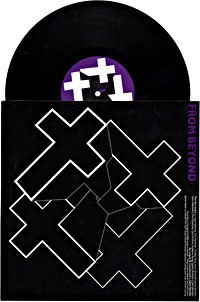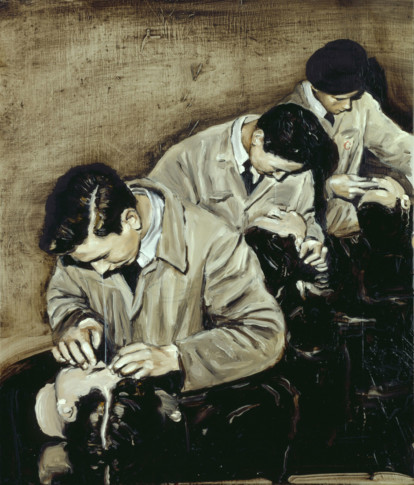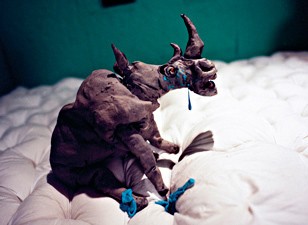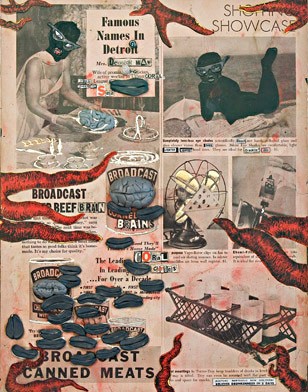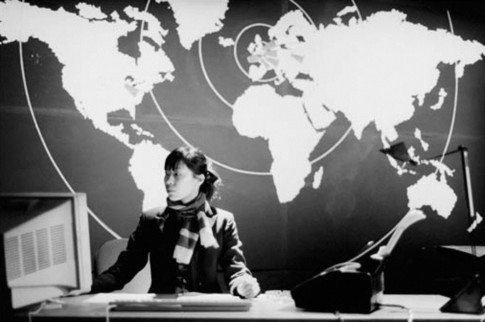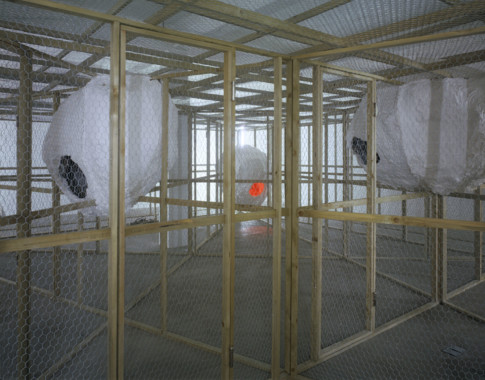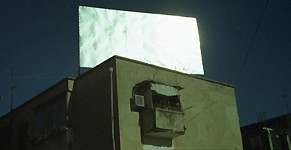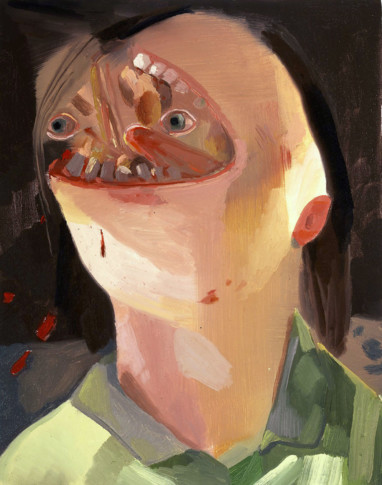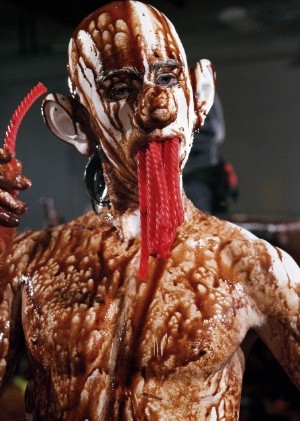
Paul McCarthy, Pirate Party, 2005 Performance photograph (Caribbean Pirates, 2001-2005 i samarbete med Damon McCarthy). Courtesy Hauser & Wirth Zürich London
Paul McCarthy
These substances have three symbolic levels: as colours, as consumer products (food), and as body fluids. They occur in huge amounts that are uncontrollable and ooze out in a way that can alarm and disgust the onlooker.
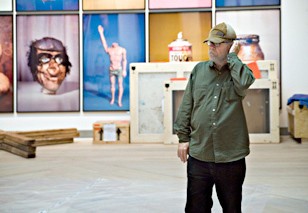
Paul McCarthy at Moderna Museet, 2006
Photo: Åsa Lundén/Moderna Museet
Excessiveness and loss of control are recurring themes even in McCarthy’s earliest works from the late 1960s. Too Steep, Too Fast is a performance that he later presented also as an instructional work: “Run down a hill. The angle of the hill should increase so that one has the sensation of falling” (1968, 1970, 1972). The work involves an element of immediate physical danger, and the contrast between the dry, matter-of-fact instructions and the implementation of the work is almost comical. In several of his filmed performances from the 1970s this comicality is obvious, for instance in Spinning (1970), where he spins around and around, in a fairly small room so his outstretched arms hit the walls. This theme is apparent in many works with a labyrinthine architecture and rotating or overturned rooms, as in Inverted Hallways and Inverted Rooms (1970), where the symmetry of the images entail that it is not immediately clear that the photos have been turned upside-down, and the sculpture/installation The box (1999), a full-scale replica of McCarthy’s studio – with all its contents bolted to the floor and overturned. Variations on this theme include spinning rooms or cameras, as in Picabia Love Bed, Dream Bed (1999), upside-down cameras that confuse perception and disturb our idea of space along with movements that create or reflect altered states of consciousness. The loss of control also recurs in the movements and words that are repeated in the performances like mantras and appear to put the artist in a trance. McCarthy also seems to be out of control in many of the videos where he acts hysterical, comical and pathetic, but where this can quickly change to something dangerous, as with alcoholic, violent men. The latent violence that sometimes breaks out always appears pointless and baffling, unlike the violence in entertainment, the media and politics, which people try to explain and sometimes justify: “I find life itself confusing, overwhelming, inexplicable. I used to see the absurdity of life and the buffoon as central elements of what I was doing, the absurdity of existence and buffoonery.”
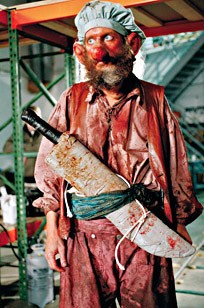
Paul McCarthy/ Damon McCarthy
Caribbean Pirates, 2005
Courtesy the artists and Hauser & Wirth Zürich London
© Ann-Marie Rounkle
In his performances and videos McCarthy has developed from structural experimental movies and videos documenting a kind of action painting, towards dressing up as different personas, playing parts. This has required a growing amount of props that can attain the status of art in their own right, as relics and sculptures. His props include masks. These evoke both horror movies and Disney characters and link him to the Surrealist tradition with its fascination for mannequins and robots – and their Freudian connections to “the uncanny”. The masks, props and sets make McCarthy’s fantastic performances and installations theatrical and mediated. This distinguishes him from other performance artists who are interested in the genre as an expression of something authentic ad immediate. On the other hand, McCarthy presents the mediated and enacted just as frightening and real as if it were “genuine”.
Over the past ten years, McCarthy has been engaged in several enormous art projects that have each generated video works with a large cast of actors in costume, stage sets that have been converted into installations, sculptures and sculpture groups, photographs and works in all kinds of media. The working titles, The Pirate Project and The Western Project, have largely been replaced with the names of the seemingly endless stream of works generated by the projects, but they nevertheless indicate the thematic starting-point. Caribbean Pirates features a large frigate with a crew of pirates. Beyond the control of their own civilisation, the pirates live out their cruel fantasies, of plunder and rape. In Fort F… another myth, another aspect of the American identity, “how the west was won”, is parodied. Again, the theme is colonialism. The large cast of actors play both pilgrims and the cavalry.
Magnus af Petersens
Paul McCarthy
Born 1945. Lives and works in Altadena, CA
Education
1973 University of Southern California, Los Angeles [US]
1969 San Francisco Art Institute, San Francisco [US]
1966–1968 University of Utah, Salt Lake City [US]
Selected solo exhibitions
2007
Paul McCarthy’s Chocolate Factory, Maccarone Gallery, New York, NY [US]
Paul McCarthy – Air Born / Air Borne / Air Pressure, Middelheim Sculpture Museum, Antwerpen/Antwerp [BE]
2006
Paul McCarthy – Head Shop/Shop Head, Moderna Museet, Stockholm [SE] Turné till/Travelled to: ARoS Aarhus Museum of Art, Arhus [DK], S.M.A.K. Stedelijk Museum voor Actuele Kunst, Gent [BE]
2005
Paul McCarthy: LaLa land parodie paradies, Haus der Kunst, München/Munich [DE] Turné till/Travelled to: Whitechapel, London [GB]
Selected group exhibitions
2007
There is never a stop and never a finish. Werke aus der Friedrich Christian Flick Collection im Hamburger Bahnhof. In memoriam Jason Rhoades, Hamburger Bahnhof, Berlin [DE]
2006
Into Me/Out of Me, P.S.1, New York, NY [US] Turné till/Travelled to: KW Institute for Contemporary Art, Berlin [DE], MACRO – Museo d’Arte Contemporanea Roma, Rome [IT]
Of Mice and Men, 4th Berlin Biennial, Berlin [DE]
2005
Les grands spectacles: 120 Jahre Kunst und Massenkultur, Museum der Moderne, Salzburg [AT]
Dionysiac, Centre Georges Pompidou, Paris [FR]
Selected bibliography
Paul McCarthy. Head Shop/Shop Head (utst.kat./exh. cat.), Magnus af Petersens, Paul McCarthy (red./eds.), Moderna Museet, Stockholm, Göttingen: Steidl, 2006, ill.
LaLa Land Parody Paradise (utst.kat./exh. cat.), Stephanie Rosenthal (red./ed.), Haus der Kunst, Ostfildern-Ruit: Hatje Cantz Verlag, 2005, ill
Paul Mc Carthy, Piccadilly Circus: Bunker Basement (artist’s book), Zürich: Scalo Verlag, 2004
Paul McCarthy, Tokyo Santa (artist’s book), Cologne: Verlag der Buchhandlung Walther König, 2004
Paul McCarthy: Brain Box Dream Box (utst.kat./exh. cat.), Eva Meyer-Hermann (red./ed.), Van Abbemuseum Eindhoven, Düsseldorf: Richter Verlag, 2004
Paul McCarthy at Tate Modern (utst.kat./exh. cat.), Tate Modern, London: Tate Publishing, 2003

